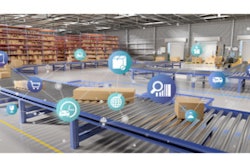
Global supply chains across all industries have seen significant disruptions due to the pandemic, creating a domino effect of issues. Every level of the supply chain system is affected by the current and predicted complications starting with international cargo movements all the way down to individual stores. One of the ways the industry is looking to overcome these challenges is with Internet of Things (IoT)-based technologies, which help digitize supply chains and enable a more seamless process. These IoT improvements are especially noteworthy ahead of the holidays when the National Retail Federation (NRF) reports that retailers rely on the holidays to generate upwards of 30% of annual sales, however, those sales are dependent on enough inventory.
Wireless connection technology empowers companies to better track assets any business deems high-value, mission-critical or significant across the global supply chain during a time of disruption. The Coronavirus disease (COVID-19) put the need for supply chain improvements at the forefront, and the upgrades that the industry adopts now will only impact supply chain and business operations in the future. Thankfully, Bluetooth technology and other IoT providers have already deployed systems that aim to lessen the blow of the current supply chain crisis and help industries prepare for the new normal as some expect the crisis will never truly end.
How IoT technology can help
Asset tracking is not a new idea. While legacy logistical and tracking systems used to suffice, modern-day businesses now need more advanced tools to keep track of shipments, assets and inventory – leaving IoT devices and networks to simplify the process. Bluetooth asset tracking leverages intelligent and automated technology without creating additional burdens for employees. The core technology of asset tracking is battery-less network tags, which connects to a network and sends locational information to a central dashboard or hub that employees can monitor. The tag, a network to scan the tags, and an interface to display the information, are the triad that enables the entire system. Bluetooth sensing devices track valuable assets throughout an item’s travel to give asset owners continuous visibility into the object’s location and shipping conditions, along with a guarantee that the item is getting to the correct location.
Some businesses who have yet to adopt more modern solutions may be concerned that these complex asset tracking systems will also require learning new interfaces, however, the flexibility of wireless technology means this is not necessary. All modern smartphones and most computers are Bluetooth compatible, so businesses do not need any extra technology to get their asset tracking systems off the ground. Rather than teaching employees an entirely new device, the data from the tracking tags is automatically stored, so any Bluetooth device with permissions can read and interpret the data. This information is also not tied to a single platform as the data first lives on a Bluetooth dashboard, which users can then send the data elsewhere (including the cloud) depending on their needs.
Digital and physical storefront benefits
More clarity and transparency always improve operations, and the same can be said with asset tracking. Storefronts, online businesses and local vendors might not be the ones placing the tags or tracking a shipment across an ocean, but those organizations still benefit from tag tracking. When an order, asset, pallet or any other tracked item enters the system, it now has a digital history detailing all movements, which gives the endpoint store a better estimate of when the items will arrive. Overall, this process allows businesses to have a more accurate picture of their inventory which is key especially around the holiday season.
The improvements at the distributor or manufacturer level also benefit endpoint stores. Fewer issues further up the supply chain ultimately means fewer issues at the end of the chain and during crunch seasons such as the holidays. When stores have more customers than any other time of the year and inventory is already low, any system that improves holiday operations will result in better margins. In addition, the tag tracking system lets manufacturers find missing items more quickly and can analyze and improve work-in-process (WIP) tracking so that the entire process runs faster.
Real-world scenarios for asset tracking
While IoT tags were mainly developed for shipping and supply chain uses, there are other real-life examples of this technology flourishing.
· Machines do most of the heavy lifting in warehouses, but those machines need repairs and regular maintenance to perform safely. Battery-less tags also work on machinery, and users can set up alerts when it is time for a particular machine to receive updated maintenance. The same network that tracks orders coming and going can track individual machines for detailed data that keeps the warehouse in top shape. Any connected device will merge into the network and become part of the data dashboard to create specific alerts, reminders and functions.
· Some of the highest trafficked places in today also handle the highest volume of goods coming and going. Malls and airports, for example, see some of the greatest quantities and highest-profile shipments out of commonplaces. With so much cargo transporting to different locations, having a simple tracking system in place can prevent many inefficiencies and bottlenecks. Malls similarly deal with a high volume, but the cargo must move through a customer-facing space that adds complexities.
- E-commerce websites may not have a public-facing footprint, but the goods must be stored and shipped to customers from wherever the inventory is held. Many online stores hope to receive what they ordered to fulfill customer orders and end the day with a proper inventory count, but logistical issues can ruin those plans. Even if deliveries cannot be perfect, an asset tracking system will let store owners know precisely how much inventory they have on hand to prevent overselling items that don’t exist. Knowing asset count quickly helps companies know if they should try overstocking a specific item if inventory is low to prepare for the future.
The pandemic put pressure on the supply chain, but the current issues are pushing the situation even further. Many factors have led to this less-than-ideal situation, but the pressure has pushed solutions like IoT tracking to find workarounds. No one technology can fix port issues or domestic shipping woes, but asset tracking can make the overall process smoother and more straightforward. High intensity seasons such as the holidays can make upgrades, improvements and advancements an even higher priority as businesses look to helpful tools to help navigate the end-of-year chaos. Many small issues and slowdowns can be removed with the power of Bluetooth networks and battery-less tags that do not put an extra burden on users. IoT technology solutions are here to stay, and who knows what industry development will come next.



















